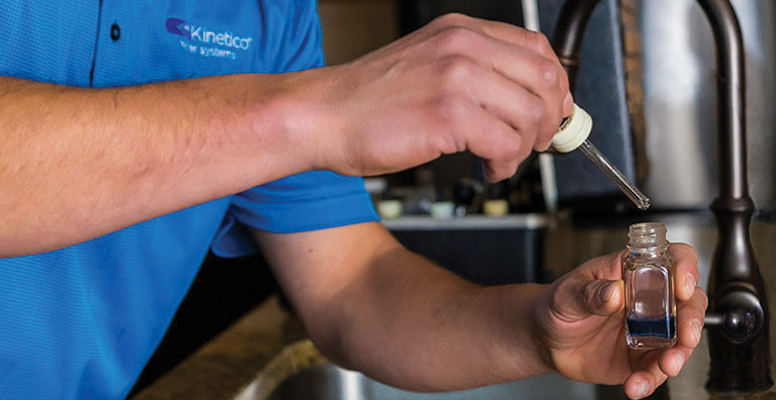Why Is Water Testing Important? Water quality can no longer be taken for granted. There are many variables that can come into play: the possibility of contaminated water, our aging water distribution system, unknown well-water quality and the type of plumbing in your home. Many don’t realize it’s common for municipalities to supply you with hard water too. If your home has water supplied by the city, it probably meets federal standards, but are those standards your standards?
Public water treatment facilities work very hard to ensure your city water is safe to drink. Unfortunately, some contaminants may be difficult to detect or treat realistically on a large scale. And after the water leaves the treatment plant, contaminants can also enter the water system through gaps in the infrastructure or from aging pipes.
Private water sources, or wells, have their own challenges and need extra attention and precautions. Since a private well’s water quality is at risk when the water comes in contact with naturally-occurring and man-made contaminants, it needs to be regularly tested to ensure it’s safe to drink.
Whether your home’s water is supplied by a municipality or a private well, it is important to understand what is and isn’t in your water. By having your water tested, you will learn about the quality of your water, if any contaminants are present and what water treatment options are available to improve your water.
We test for the following common water contaminants and problems:

Arsenic is a naturally-occurring metalloid element, commonly found in groundwater. According to the Centers for Disease Control and Prevention, arsenic can enter the water supply from natural deposits in the earth or from industrial and agricultural pollution. In drinking water, it is tasteless and odorless. Most people are alarmed when they learn that their drinking water, from a public or private water source, may contain any amount of arsenic.
I. LEAD
Lead is a metallic substance that is a major concern if it makes its way into water supplies. Our aging infrastructure is a problem since older water pipes containing lead can leach lead into pubic water supplies. Municipalities are required to supply water that meets federal standards. The water may be safe to drink and free from lead when it leaves the plant, but it can encounter lead in service lines as it is transported from the plant to your home. Older homes with lead pipes could also contribute to a lead problem. The use of a home water filter using reverse osmosis is the most effective method for eliminating lead from drinking water supplies.

II. Cloudy or Grayish Water
Cloudy or grayish water is usually caused by dissolved or suspended solids. This is referred to as turbidity. Water can become turbid naturally or from things such as construction, storms and urban runoff. There are varying degrees of turbidity, but even if your water looks clear, it could still contain a high level of dissolved solids. To determine the turbidity level of your water, we suggest having your water tested for total dissolved solids.
III. Iron
Water is a natural solvent. Given the needed time and conditions, it will dissolve anything it meets. What your water encounters often determines the contaminants it may contain. Depending on where you live, your water may have iron in it, which can cause rusty-orange or black stains on clothes, fixtures, sinks, tubs, water-using appliances and toilets. Iron can even alter hair color. Iron stains are very difficult to remove, if you can get rid of them at all. Testing your water source will confirm the presence and type of iron in your water, so you can select the proper water treatment system to handle it.
IV. Hard Water
As water moves through the earth, it dissolves rocks and minerals, specifically calcium and magnesium, making your water “hard.” Hard water is a real nuisance, leaving spots on glasses and silverware, scale in water-using appliances, on fixtures, shower doors and tubs, and making hair dull and skin dry. Most homes have hard water, regardless of how you get your water. A simple, in-home water test will tell you how hard your water is, so you can choose the most appropriate water softener, if needed.
V. Bacteria and Viruses
Each year there are millions of cases of waterborne acute gastrointestinal illness annually in the United States alone. These illnesses are often caused by bacteria, viruses and protozoa that make their way into water supplies. Even sophisticated treatment plants cannot ensure that drinking water is completely free of bacteria and viruses. If you are concerned about bacteria and viruses in your water, have it tested.

Schedule a In-Home Water Test with a KarSare Professional
A great way to learn what is in your water is to have an in-home water test conducted by a certified water professional. Testing the water in your home allows a water professional to check the water at the source, as soon as it comes out of the faucet or spicket. A Kinetico water professional will collect samples from your water source and conduct various tests right in your home, for free. You’ll receive a detailed water analysis as well as a water treatment recommendation to resolve any water problems your test results indicate. Fill out the form below to schedule a free water test today to improve your home’s water.
Water Testing FAQs
Should I have my water tested?
“The answer to this question depends on several factors. It concerns your health and the health of your family, so you need to know some basic facts. In addition to illness, a variety of less serious problems such as taste, color, odor and staining of clothes or fixtures are signs of possible water quality problems. Other things to think about include the nearness of your water well to septic systems and the composition of your home’s plumbing materials.” – EPA (read Home Water Testing guidelines.)
Should I use a DIY Water Test Kits?
Do-it-yourself test kits are often good at testing for common water contaminants but do not always provide a detailed water analysis.
Should I use laboratory water test?
In some cases, your water may need further analysis to determine if there are deeper or more complex water issues. If you suspect a water problem that cannot be detected with an in-home test, let your KarSare water professional know. They can provide you with laboratories that can perform more detailed water tests. If you have laboratory tests performed, be sure to share the results with your KarSare water professional. They can explain the findings and help you determine the best course of action to treat your water.
How frequently should I test?
“Test water every year for total coliform bacteria, nitrates, total dissolved solids and pH levels, especially if you have a new well, or have replaced or repaired pipes, pumps or the well casing.” – EPA

